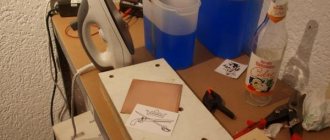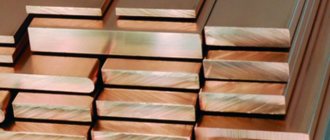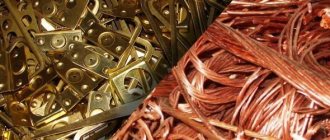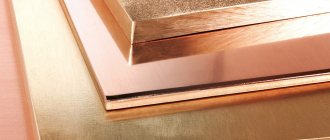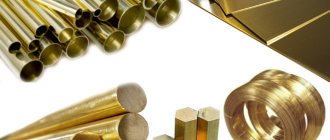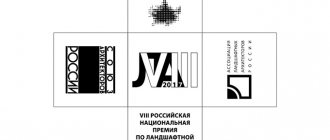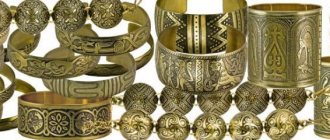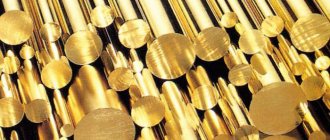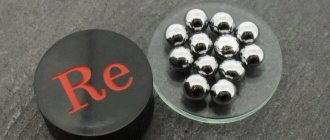Copper (lat. Cuprum) is a chemical element of group I of the periodic system of Mendeleev (atomic number 29, atomic mass 63.546). In compounds, copper usually exhibits oxidation states +1 and +2; a few trivalent copper compounds are also known. The most important copper compounds: oxides Cu2O, CuO, Cu2O3; hydroxide Cu(OH)2, nitrate Cu(NO3)2.3H2O, sulfide CuS, sulfate (copper sulfate) CuSO4.5H2O, carbonate CuCO3.Cu(OH)2, chloride CuCl2.2H2O.
Copper is one of the seven metals known since ancient times. The transition period from the Stone to the Bronze Age (4th - 3rd millennium BC) was called the Copper Age or Chalcolithic (from the Greek chalkos - copper and lithos - stone) or Chalcolithic (from the Latin aeneus - copper and Greek lithos - stone) . Copper tools appeared during this period. It is known that copper tools were used during the construction of the Cheops pyramid.
Pure copper is a malleable and soft metal of a reddish color, pink when fractured, in places with brown and mottled tarnish, heavy (density 8.93 g/cm3), an excellent conductor of heat and electricity, second in this regard only to silver (melting point 1083oC). Copper is easily drawn into wire and rolled into thin sheets, but has relatively little activity. In dry air and oxygen under normal conditions, copper does not oxidize. But it reacts quite easily: already at room temperature it forms CuCl2 chloride with halogens, for example with wet chlorine; when heated with sulfur it forms Cu2S sulfide, with selenium. But copper does not interact with hydrogen, carbon and nitrogen even at high temperatures. Acids that do not have oxidizing properties do not act on copper, for example, hydrochloric and dilute sulfuric acids. But in the presence of atmospheric oxygen, copper dissolves in these acids to form the corresponding salts:
2Cu + 4HCl + O2 = 2CuCl2 + 2H2O.
In an atmosphere containing CO2, H2O vapors, etc., it becomes covered with patina - a greenish film of basic carbonate (Cu2(OH)2CO3)), a toxic substance.
Copper is found in more than 170 minerals, of which only 17 are important for industry, including: bornite (variegated copper ore - Cu5FeS4), chalcopyrite (copper pyrite - CuFeS2), chalcocite (copper luster - Cu2S), covellite (CuS), malachite (Cu2(OH)2CO3). Native copper is also found
Characteristics of copper
- Copper density - 8.93*103kg/m3;
- Specific gravity of copper - 8.93 g/cm3;
- The specific heat capacity of copper at 20oC is 0.094 cal/deg;
- The melting point of copper is 1083oC;
- Specific heat of fusion of copper - 42 cal/g;
- The boiling point of copper is 2600oC;
- Linear expansion coefficient of copper
- (at a temperature of about 20oC) - 16.7 * 106 (1/deg);
- Thermal conductivity coefficient of copper is 335 kcal/m*hour*deg;
- Copper resistivity at 20oC - 0.0167 Ohm*mm2/m;
Copper as a metal and raw material in construction: its features and processing nuances
Most industrial sectors use a metal such as copper. Due to its high electrical conductivity, not a single area of electrical engineering can do without this material. It produces conductors with excellent performance characteristics. In addition to these features, copper has ductility and refractoriness, resistance to corrosion and aggressive environments. And today we will look at the metal from all sides: we will indicate the price for 1 kg of scrap copper, we will tell you about its use and production.
Copper connections
Copper (I) oxide Cu2O3 and cuprous oxide (I) Cu2O , like other copper (I) compounds, are less stable than copper (II) compounds. Copper (I) oxide, or cuprous oxide Cu2O, occurs naturally as the mineral cuprite. In addition, it can be obtained as a precipitate of red copper(I) oxide by heating a solution of a copper(II) salt and an alkali in the presence of a strong reducing agent.
Copper(II) oxide, or copper oxide, CuO is a black substance found in nature (for example, as the mineral tenerite). It is obtained by calcination of copper (II) hydroxycarbonate (CuOH)2CO3 or copper (II) nitrate Cu(NO2)2. Copper(II) oxide is a good oxidizing agent.
Copper (II) hydroxide Cu(OH)2 precipitates from solutions of copper (II) salts under the action of alkalis in the form of a blue gelatinous mass. Even with low heating, even under water, it decomposes, turning into black copper (II) oxide. Copper(II) hydroxide is a very weak base. Therefore, solutions of copper (II) salts in most cases have an acidic reaction, and with weak acids copper forms basic salts.
Copper (II) sulfate CuSO4 in the anhydrous state is a white powder that turns blue when it absorbs water. Therefore, it is used to detect traces of moisture in organic liquids. An aqueous solution of copper sulfate has a characteristic blue-blue color. This color is characteristic of hydrated [Cu(H2O)4]2+ ions, therefore all dilute solutions of copper (II) salts have the same color, unless they contain any colored anions. From aqueous solutions, copper sulfate crystallizes with five molecules of water, forming transparent blue crystals of copper sulfate. Copper sulfate is used for electrolytic coating of metals with copper, for the preparation of mineral paints, and also as a starting material in the preparation of other copper compounds. In agriculture, a diluted solution of copper sulfate is used to spray plants and treat grain before sowing to destroy spores of harmful fungi.
Copper (II) chloride CuCl2. 2H2O. Forms dark green crystals, easily soluble in water. Very concentrated solutions of copper (II) chloride are green, diluted solutions are blue-blue.
Copper (II) nitrate Cu(NO3)2.3H2O. It is obtained by dissolving copper in nitric acid. When heated, blue copper nitrate crystals first lose water and then easily decompose, releasing oxygen and brown nitrogen dioxide, turning into copper (II) oxide.
Copper (II) hydroxycarbonate (CuOH)2CO3. It occurs naturally in the form of the mineral malachite, which has a beautiful emerald green color. It is artificially prepared by the action of Na2CO3 on solutions of copper (II) salts. 2CuSO4 + 2Na2CO3 + H2O = (CuOH)2CO3v + 2Na2SO4 + CO2^ Used to obtain copper (II) chloride, for the preparation of blue and green mineral paints, as well as in pyrotechnics.
Copper (II) acetate Cu (CH3COO)2.H2O. It is obtained by treating copper metal or copper(II) oxide with acetic acid. Usually it is a mixture of basic salts of various compositions and colors (green and blue-green). Under the name verdigris, it is used to prepare oil paint.
Complex copper compounds are formed as a result of the combination of doubly charged copper ions with ammonia molecules. A variety of mineral paints are obtained from copper salts. All copper salts are poisonous. Therefore, to avoid the formation of copper salts, copper utensils are coated on the inside with a layer of tin (tinned).
Processing methods
Mechanical processing can be done by:
- Broaches. A technological process used in the manufacture of wires and wires of different diameters. An extruder mechanism is used for production.
- Rolling. Technological process for the production of flat copper products. The workpieces are rolled through a machine with movable rollers.
- Polishing. To give copper products a characteristic metallic shine, felt and fabric discs are used.
- Grinding. It is used to remove a certain layer of metal, clean it from plaque and dirt. Grinding is carried out using abrasives.
The turning method of processing copper blanks also deserves attention. It is used to manufacture washers, studs, fittings, bushings, and flanges.
Copper is a sought-after non-ferrous metal with good physical and chemical properties. The metal is suitable for making jewelry, parts of industrial machines, household appliances, and radio components.
Copper production
Copper is mined from oxide and sulfide ores. 80% of all mined copper is smelted from sulfide ores. Typically, copper ores contain a lot of gangue. Therefore, a beneficiation process is used to obtain copper. Copper is obtained by smelting it from sulfide ores. The process consists of a number of operations: roasting, smelting, converting, fire and electrolytic refining. During the firing process, most of the impurity sulfides are converted into oxides. Thus, the main impurity of most copper ores, pyrite FeS2, turns into Fe2O3. The gases produced during roasting contain CO2, which is used to produce sulfuric acid. The resulting oxides of iron, zinc and other impurities during the firing process are separated in the form of slag during melting. Liquid copper matte (Cu2S with an admixture of FeS) enters the converter, where air is blown through it. During conversion, sulfur dioxide is released and crude or raw copper is obtained. To extract valuable (Au, Ag, Te, etc.) and to remove harmful impurities, blister copper is first subjected to fire and then electrolytic refining. During fire refining, liquid copper is saturated with oxygen. In this case, impurities of iron, zinc and cobalt are oxidized, turn into slag and are removed. And copper is poured into molds. The resulting castings serve as anodes during electrolytic refining.
The main component of the solution during electrolytic refining is copper sulfate - the most common and cheapest copper salt. To increase the low electrical conductivity of copper sulfate, sulfuric acid is added to the electrolyte. And to obtain a compact copper deposit, a small amount of additives is introduced into the solution. Metal impurities contained in crude (“blister”) copper can be divided into two groups.
- Fe, Zn, Ni, Co. These metals have significantly more negative electrode potentials than copper. Therefore, they anodicly dissolve together with copper, but are not deposited on the cathode, but accumulate in the electrolyte in the form of sulfates. Therefore, the electrolyte must be replaced periodically.
- Au, Ag, Pb, Sn. Noble metals (Au, Ag) do not undergo anodic dissolution, but during the process they settle at the anode, forming anode sludge together with other impurities, which is periodically removed. Tin and lead dissolve together with copper, but in the electrolyte they form poorly soluble compounds that precipitate and are also removed.
How to tell the difference?
Most often you can distinguish by:
without the use of any tools or equipment.
But there are situations when, for accuracy, it is necessary to use :
- reagents,
- tools,
- devices.
Before assessing the scrap that you are going to take to the collection point, you need to clean it of dirt, otherwise you won’t be able to accurately determine it by eye.
By color
Both metals, although to varying degrees, can develop a patina .
Therefore, do not forget to clean the scrap well.
If an object has been in the open air or in water for a long time, the patina layer is difficult to remove.
Sometimes it will be justified to purchase a special cleaning product .
It is advisable to inspect the scrap under a powerful white light.
This implies that one can view either under the sun on a fine day or under a bright fluorescent lamp . Incandescent lamp is not suitable.
Pure copper will have a reddish-brown tint, sometimes with a pink tint. Keep in mind that brass can be red or orange. This type is commonly used for decorations and water pipes.
If the material has an orange, yellow or golden tint, you can be almost sure that it is brass.
If you are engaged in the collection and delivery of scrap metal, then it will be useful for you to know the prices for ferrous scrap metal. If you don’t know where to find ferrous metals, then read this article. Not sure which metal detector model to choose? Check out the review of popular models https://rcycle.net/metally/cvetnye/metalloiskateli-vidy-modelj-i-ceny.
It can also be light golden , pale yellow , and even off-white , but it is very rare for metal detectors, since such an alloy is difficult to process, and it is used mainly in jewelry.
The best recommendation is to carry an item that you are absolutely sure is made of pure copper . You will be able to compare it with the crowbar you found. Most often this method works well.
By sound
Another method that does not require special skills or equipment. You can learn to distinguish metals by sound after a short training. Hit the object with something metal. If it is made of copper, the sound will be muffled and low . This happens because the metal is soft.
Visual inspection and testing for sound and hardness are usually sufficient for field determination.
On the contrary, brass will produce a ringing and high-pitched sound when struck. The second most important inspection method for those who deal with scrap metal is after visual assessment in the light. But this method is justified only with large and voluminous objects - you need something to make a sound.
By hardness
Copper, as mentioned above, is a soft metal. Brass was specifically created to increase the hardness of copper while maintaining some of its other characteristics. Therefore, when damage is caused to scrap, copper will be the material that is more easily deformed . Brass, on the other hand, can withstand impacts .
By labeling
If an item has markings on it, identifying the metal or alloy can be simple and accurate.
As a rule, brass is marked with a mark that begins with the symbol “L” .
Accordingly, copper markings begin with “M” . True, copper quite often does not have any markings.
Here are some transcripts that may be useful:
- Copper markings begin with one letter “M” , followed by numbers. letter “L” on brass products; it can be followed by more letters, and only then by numbers.
- In the United States and Canada, the UNS , according to which brass is marked C2, C3, C4 .
- In the European Union, both metals are marked with the letter C , it all depends on the subsequent letters. For copper they will be B , C, D , and for brass alloy - L, M, N, P and R.
- Not so long ago, labeling consisting of icons of chemical elements was common. For example, Cu Zn (cuprum - zinc) will mean brass.
Copper alloys
Alloys that increase the strength and other properties of copper are obtained by introducing additives into it, such as zinc, tin, silicon, lead, aluminum, manganese, and nickel. More than 30% of copper is used for alloys.
Brasses are alloys of copper and zinc (copper from 60 to 90% and zinc from 40 to 10%) - stronger than copper and less susceptible to oxidation. When silicon and lead are added to brass, its anti-friction qualities increase; when tin, aluminum, manganese and nickel are added, its anti-corrosion resistance increases. Sheets and cast products are used in mechanical engineering, especially in chemical, optics and instrument making, and in the production of meshes for the pulp and paper industry.
Bronze. Previously, bronzes were alloys of copper (80-94%) and tin (20-6%). Currently, tin-free bronzes are produced, named after the main component after copper.
- Aluminum bronzes contain 5-11% aluminum and have high mechanical properties combined with anti-corrosion resistance.
- Lead bronzes containing 25-33% lead are used mainly for the manufacture of bearings operating at high pressures and high sliding speeds.
- Silicon bronzes containing 4-5% silicon are used as cheap substitutes for tin bronzes.
- Beryllium bronzes containing 1.8-2.3% beryllium are distinguished by hardness after hardening and high elasticity. They are used for the manufacture of springs and spring products.
- Cadmium bronzes - copper alloys with a small amount of cadmium (up to 1%) - are used in the production of trolley wires, for the manufacture of fittings for water and gas lines and in mechanical engineering.
Solders are alloys of non-ferrous metals used in soldering to produce a monolithic soldered seam. Among hard solders, copper-silver alloy is known (44.5-45.5% Ag; 29-31% Cu; the rest is zinc).
Areas of application
Areas of application:
- Making tools with thin blades.
- Production of tableware, decorations.
- Manufacturing of wires and radio components.
- Pipe production. Elements for assembling pipelines made from this non-ferrous metal are considered the best when compared with products from other materials.
- Assembly of household appliances.
Copper pipes
origin of name
Did you know that Cuprum is the Latin name for copper, derived from the name of the island of Cyprus? By the way, Strabo calls copper chalkos - the city of Chalkis on Euboea is responsible for the origin of this name. Most of the ancient Greek names for copper and bronze objects came from this word. They have found wide application in blacksmithing, and among blacksmithing and casting. Copper is sometimes called Aes, meaning ore or mine.
The Slavic word “copper” does not have a clear etymology. Perhaps it is old. But it is very often found in the most ancient literary monuments of Russia. V.I. Abaev assumed that this word came from the name of the country of Midia. Alchemists nicknamed copper "Venus". In more ancient times it was called "Mars".
